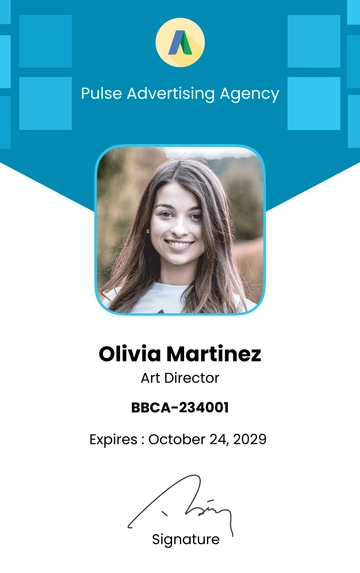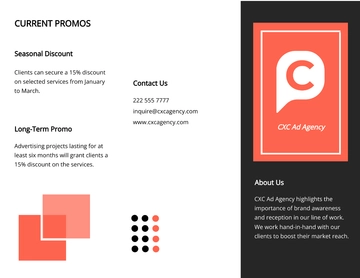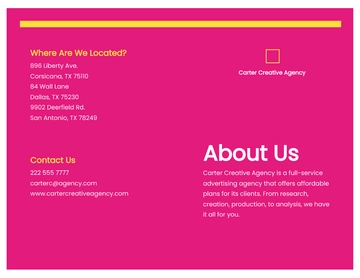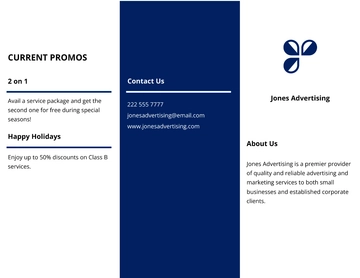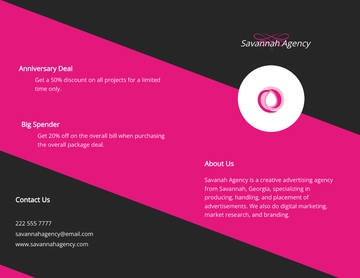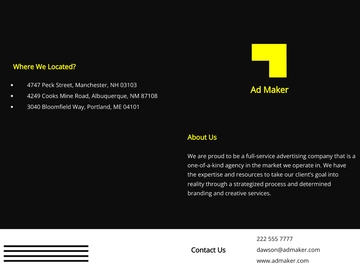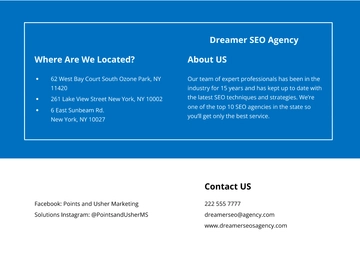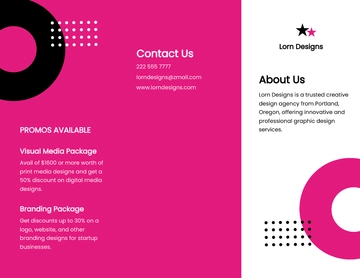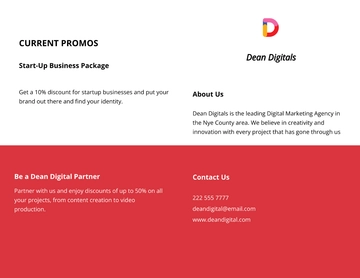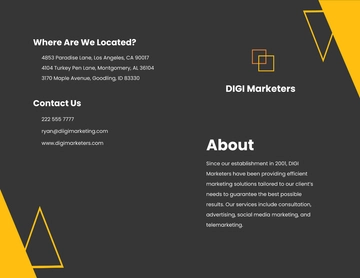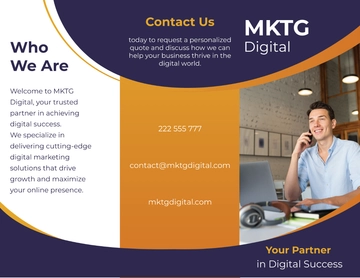Free Advertising Long-term Financial Planning for Campaigns
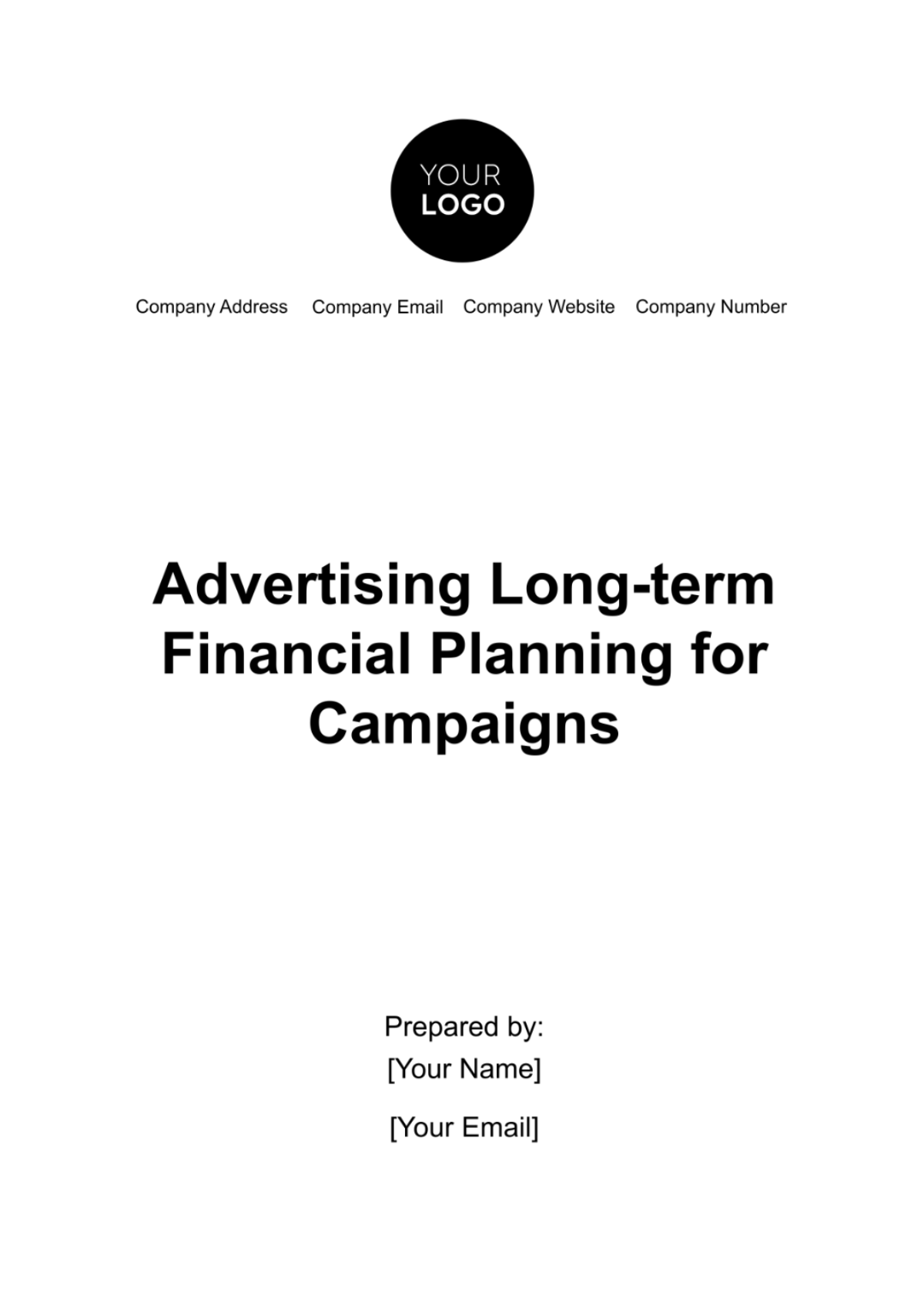
I. Executive Summary
In today's rapidly evolving advertising landscape, strategic long-term financial planning is paramount for [Your Company Name] to maintain a competitive edge and achieve sustained growth. This executive summary provides a concise overview of our overarching financial objectives for advertising over the coming years and outlines the key strategies and objectives that will guide our efforts. By aligning our advertising goals with the broader business growth targets and establishing clear KPIs, we ensure that our advertising campaigns are both effective and financially sustainable.
A. Overview of Long-term Financial Goals for Advertising
Articulation of Overarching Financial Objectives Over a Multi-Year Period
We aim to increase advertising-driven revenue by 30% over the next five years. This target aligns with our ambition to expand market share and enhance brand visibility. Investment in advertising is projected to grow annually, focusing on high-return channels.
Alignment of Financial Goals with Broader Business Growth Targets
The advertising budget is structured to support the company's overall growth strategy, including entering new markets and launching new product lines. We aim to ensure that every advertising dollar spent contributes to these broader business objectives.
B. Summary of Key Advertising Strategies and Objectives
Outline of Primary Advertising Strategies to Achieve Long-term Goals
Our strategy includes a significant shift towards digital and interactive advertising, leveraging data analytics for targeted campaigns, and experimenting with emerging technologies like augmented reality and programmatic advertising.
Identification of Key Performance Indicators (KPIs) and Objectives
Key metrics for evaluating the success of our advertising initiatives include customer acquisition cost, return on ad spend (ROAS), engagement rates, and conversion rates. These KPIs will be closely monitored to ensure that our advertising efforts align with our financial goals and business growth targets.
This executive summary sets the stage for a detailed exploration of each aspect of our long-term financial planning for advertising campaigns. It reflects [Your Company Name]'s commitment to strategic planning, financial discipline, and continual adaptation to the changing advertising environment.
II. Market Analysis and Forecasting
As [Your Company Name] navigate through the dynamic advertising landscape, an in-depth understanding of market trends and a keen awareness of the competitive environment are crucial. This section of the document focuses on evaluating current and emerging trends in the market, their impact on advertising strategies, and a comprehensive assessment of the competitive landscape. These insights are fundamental in shaping effective and responsive advertising strategies.
A. Evaluation of Current and Emerging Market Trends
Analysis of Market Dynamics Impacting Advertising Strategies
We delve into current trends such as the surge in mobile advertising, the growing importance of content marketing, and the increasing role of data analytics in targeting and personalization. Our analysis also covers the rapid adoption of technologies like AI and VR in advertising, assessing how these innovations can be integrated into our strategies.
Forecasting Future Trends and Consumer Behaviors
Anticipating future market shifts, we predict a continued rise in digital advertising, focusing on interactive and immersive experiences. Consumer behavior is expected to further tilt towards personalized and contextually relevant advertising, driven by advancements in data analysis and machine learning.
B. Competitive Landscape Assessment
Overview of Competitors' Advertising Strategies and Spending
A thorough examination of our key competitors reveals their advertising spending, focus areas, and campaign successes. This analysis includes exploring their digital vs. traditional media spending and their adoption of new advertising technologies.
Identification of Market Opportunities and Threats
Based on our competitive analysis, we identify potential market opportunities, such as untapped digital platforms and niches. We also highlight potential threats, including oversaturated channels and shifts in consumer preferences, which could impact our advertising effectiveness.
III. Budget Allocation and Projections
Effective financial management is the backbone of successful advertising campaigns. In this section, we outline our approach to budget allocation and forecasting, focusing on ensuring that our financial resources are strategically aligned with our advertising goals and market realities.
A. Multi-Year Budget Planning
Projection of Advertising Budgets Over the Next 3-5 Years
We project a gradual increase in our advertising budget, aiming to align with our growth trajectory and market expansion plans. The budget projection considers factors such as expected revenue growth, market expansion plans, and technological advancements in advertising.
Annual Allocation Strategies Based on Projected Revenues and Goals
The annual budget allocation strategy is tailored to support our key advertising objectives and revenue targets. It includes provisions for scaling up successful campaigns and experimenting with new advertising initiatives.
B. Channel-Specific Allocation
Distribution of Budget Across Various Advertising Channels
Our budget allocation is diversified across digital channels (social media, search engines, programmatic ads), traditional media (TV, print), and emerging platforms. The distribution strategy optimizes reach and engagement across our target demographics.
Adaptation of Allocation Based on Changing Market Conditions and Channel Effectiveness
The allocation strategy is flexible, allowing for adjustments based on channel performance, market conditions, and emerging trends. This approach ensures that our advertising budget is utilized effectively and adaptively, maximizing ROI and market impact
This section aims to provide [Your Company Name] with a comprehensive view of the market dynamics, competitive landscape, and strategic financial planning necessary for effective advertising campaigns.
IV. Competitive Landscape Analysis
Effective campaign planning and strategic development are crucial for [Your Company Name] to achieve its advertising goals and maintain a strong market presence. This section lays out a comprehensive approach to developing a long-term campaign roadmap and crafting a creative messaging strategy that resonates with our target audience. It aims to provide a clear framework that guides our advertising efforts over an extended period, ensuring consistency, relevance, and impact.
A. Long-Term Campaign Roadmap
Development of a Strategic Roadmap for Major Advertising Campaigns
We plan to develop a multi-year roadmap outlining key advertising campaigns. This roadmap will detail the objectives, target demographics, key messages, and desired outcomes for each campaign. We will focus on aligning these campaigns with our long-term business objectives and growth plans. The roadmap will include major product launches, brand awareness campaigns, and targeted promotional activities.
Integration of Campaigns with Seasonal and Market-Driven Opportunities
Each campaign will be strategically timed to leverage seasonal trends, market events, and consumer behavior shifts. For instance, aligning specific campaigns with holiday seasons or major industry events to maximize engagement and impact. This approach ensures that our campaigns are not only well-planned but also agile and responsive to market opportunities.
B. Creative and Messaging Strategy
Establishment of a Consistent Brand Message Across Campaigns
A core focus will be establishing and maintaining a consistent brand message across all campaigns. This involves creating a unified brand voice and visual style that resonates with our audience and strengthens brand recognition. Consistency in messaging ensures that each campaign builds upon the last, reinforcing our brand's values and market position.
Plan for Creative Development and Content Strategy Over Time
We intend to develop a comprehensive plan for creative content across various channels. This includes the production of high-quality visuals, engaging copy, and innovative formats (such as interactive and video content). The plan will detail the creative development process, timelines, and content distribution strategies, ensuring that our creative efforts are both effective and efficient.
In summary, this section of the document articulates a structured approach to campaign planning and creative strategy development, crucial for [Your Company Name]'s success in the competitive advertising landscape. It underscores the importance of long-term planning, consistency in messaging, and the adaptability of campaigns to market dynamics.
V. Campaign Planning and ROI Expectations
In the realm of advertising, navigating uncertainties and preparing for potential challenges are as crucial as planning for success. The Risk Management and Contingency Planning section is designed to systematically identify and address potential risks that [Your Company Name] may encounter in its advertising endeavors. This proactive approach ensures that we are prepared to handle unforeseen circumstances effectively, minimizing their impact on our long-term advertising goals and strategies.
A. Identification of Potential Risks
Analysis of Financial, Market, and Operational Risks in Advertising
Our approach includes a comprehensive analysis of various types of risks. Financial risks involve fluctuations in advertising costs and ROI. Market risks encompass changes in consumer behavior, emerging competition, and shifts in market trends that could affect the effectiveness of our campaigns. Operational risks are related to internal processes and systems, including campaign management and technological infrastructure. Identifying these risks early allows us to take preemptive measures.
Assessment of Impact on Long-Term Planning
Each identified risk is evaluated for its potential impact on our long-term advertising objectives. For example, a sudden increase in digital ad costs could affect our budget allocations, while a shift in consumer preferences might necessitate a change in our campaign strategies. Understanding the implications of these risks helps us adjust our long-term plans to remain resilient.
B. Development of Contingency Plans
Strategies to Mitigate Identified Risks
For each significant risk, we develop specific mitigation strategies. This may include diversifying our advertising channels to reduce dependence on a single medium, investing in market research to stay ahead of consumer trends, and enhancing our operational protocols to boost efficiency and flexibility. The goal is to have ready-to-implement strategies that adapt quickly to changing circumstances.
Contingency Budgeting and Resource Allocation
An essential part of our contingency planning involves allocating a portion of our budget for unforeseen expenses and challenges. This contingency budget is designed to provide financial flexibility, allowing us to respond swiftly to unexpected situations without compromising our campaign effectiveness. Additionally, resources such as reserve manpower and backup technology systems are planned to ensure uninterrupted campaign execution.
This section underscores [Your Company Name]'s commitment to comprehensive risk management and the establishment of robust contingency plans. By anticipating and preparing for potential challenges, we aim to ensure the stability and success of our advertising efforts in a landscape that is often unpredictable.
VI. Risk Management and Contingency Planning
In the dynamic field of advertising, the ability to accurately monitor and evaluate performance is vital for long-term success. This section outlines [Your Company Name]'s comprehensive approach to performance monitoring and evaluation. By establishing key performance indicators (KPIs), setting regular review intervals, and creating a robust feedback loop, we can ensure that our advertising strategies are not only effective but also continually optimized for maximum impact.
A. Key Metrics for Long-term Success
Identification of KPIs to Track Long-term Advertising Effectiveness
We have identified a set of KPIs critical for assessing the long-term effectiveness of our advertising campaigns. These include metrics such as return on advertising spend (ROAS), conversion rates, customer acquisition cost (CAC), brand awareness levels, and customer engagement metrics. These KPIs will provide us with quantitative data to evaluate the effectiveness of our advertising strategies over time.
Regular Review Intervals and Benchmarks
To ensure that we are on track to meet our long-term goals, we have established regular intervals for reviewing our advertising performance. These reviews will occur quarterly, and we will benchmark our performance against both past results and industry standards. This practice will enable us to track our progress and make data-driven decisions.
B. Feedback Loop and Adjustments
System for Ongoing Performance Feedback
We have implemented a system to gather continuous feedback on our advertising performance. This system includes tools for real-time data analytics, customer feedback channels, and internal review meetings. By constantly monitoring our campaigns, we can quickly identify areas of success and those needing improvement.
Mechanisms for Adjusting Strategies Based on Performance Data
An essential aspect of our strategy is the ability to adapt and evolve based on performance data. We have mechanisms in place to make timely adjustments to our advertising strategies, whether it's reallocating the budget, tweaking campaign messages, or experimenting with new advertising channels. This adaptive approach ensures that our advertising strategies remain effective and relevant in an ever-changing market.
This section highlights [Your Company Name]'s dedication to systematic performance monitoring and the agility to make informed adjustments. By prioritizing these practices, we aim to sustain and enhance the effectiveness of our advertising campaigns, ensuring that they contribute significantly to our long-term business objectives.
VII. Review and Adjustment Strategies
In an industry as rapidly evolving as advertising, staying ahead of the curve regarding technological advancements and market changes is not just advantageous – it's essential. This section outlines [Your Company Name]'s strategies for embracing technological innovation and adapting to future market trends. By maintaining a forward-looking perspective and ensuring flexibility in our approaches, we aim to keep our advertising strategies relevant, effective, and ahead of our competitors.
A. Keeping Pace with Technological Advancements
Strategies to Incorporate Emerging Technologies and Platforms
[Your Company Name] is committed to integrating the latest technologies into our advertising strategies. This includes exploring opportunities in areas like augmented reality (AR), virtual reality (VR), and AI-driven programmatic advertising. We plan to allocate a portion of our R&D budget towards experimenting with these technologies, aiming to create more engaging and personalized advertising experiences.
Continuous Learning and Adaptation Approach
Recognizing the rapid pace of technological change, we have established a culture of continuous learning and adaptation within our advertising team. This involves regular training programs, attending industry conferences, and partnerships with tech companies and innovators. Staying informed about the latest trends and learning how to leverage them effectively will be a cornerstone of our approach.
B. Forward-Looking Strategic Adjustments
Anticipating Future Market Changes and Consumer Preferences
In addition to technological trends, understanding and anticipating shifts in consumer behavior and preferences are crucial. We conduct ongoing market research to identify emerging trends, such as shifts in media consumption habits or changes in consumer values. This foresight allows us to adjust our messaging and channels to stay relevant and appealing to our target audience.
Planning for Scalable and Flexible Advertising Approaches
Our advertising strategies are designed to be both scalable and flexible, allowing us to adapt quickly to changes in the market or consumer behavior. This means creating campaigns that can be easily adjusted in scope, channel, or message. It also involves maintaining a diverse mix of advertising channels to ensure we are not overly reliant on any single medium or message.
In this section, we underscore the importance of staying at the forefront of advertising trends and technological innovations for [Your Company Name]. By embracing a proactive and adaptable approach, we are not just responding to the changes in the advertising landscape; we are positioning ourselves to lead and define it.
- 100% Customizable, free editor
- Access 1 Million+ Templates, photo’s & graphics
- Download or share as a template
- Click and replace photos, graphics, text, backgrounds
- Resize, crop, AI write & more
- Access advanced editor
Discover the ultimate solution for seamless advertising financial planning with Template.net's Advertising Long-term Financial Planning for Campaigns Template. This editable and customizable tool boasts an AI Editor Tool, empowering you to forecast budgets, strategize media mix, and optimize campaigns effortlessly. Elevate your advertising game with precision and efficiency. Unlock your potential for sustained success today.












